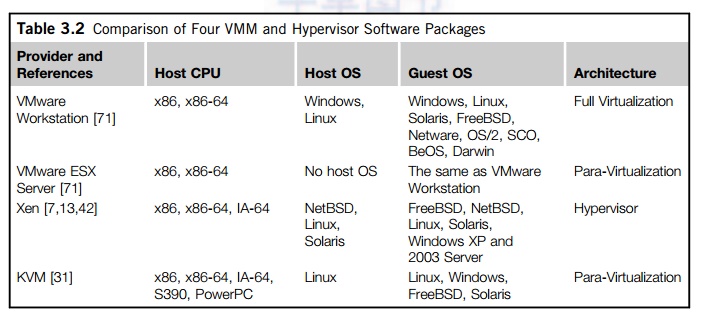Chapter: Distributed and Cloud Computing: From Parallel Processing to the Internet of Things : Virtual Machines and Virtualization of Clusters and Data Centers
VMM Design Requirements and Providers
VMM Design Requirements and Providers
As mentioned earlier, hardware-level virtualization inserts a layer between real hardware and traditional operating systems. This layer is commonly called the Virtual Machine Monitor (VMM) and it manages the hardware resources of a computing system. Each time programs access the hardware the VMM captures the process. In this sense, the VMM acts as a traditional OS. One hardware compo-nent, such as the CPU, can be virtualized as several virtual copies. Therefore, several traditional oper-ating systems which are the same or different can sit on the same set of hardware simultaneously.

There are three requirements for a VMM. First, a VMM should provide an environment for pro-grams which is essentially identical to the original machine. Second, programs run in this environment should show, at worst, only minor decreases in speed. Third, a VMM should be in complete control of the system resources. Any program run under a VMM should exhibit a function identical to that which it runs on the original machine directly. Two possible exceptions in terms of differences are permitted with this requirement: differences caused by the availability of system resources and differences caused by timing dependencies. The former arises when more than one VM is running on the same machine.
The hardware resource requirements, such as memory, of each VM are reduced, but the sum of them is greater than that of the real machine installed. The latter qualification is required because of the intervening level of software and the effect of any other VMs concurrently existing on the same hardware. Obviously, these two differences pertain to performance, while the function a VMM pro-vides stays the same as that of a real machine. However, the identical environment requirement excludes the behavior of the usual time-sharing operating system from being classed as a VMM.
A VMM should demonstrate efficiency in using the VMs. Compared with a physical machine, no one prefers a VMM if its efficiency is too low. Traditional emulators and complete software interpreters (simulators) emulate each instruction by means of functions or macros. Such a method provides the most flexible solutions for VMMs. However, emulators or simulators are too slow to be used as real machines. To guarantee the efficiency of a VMM, a statistically dominant subset of the virtual processor’s instructions needs to be executed directly by the real processor, with no software intervention by the VMM. Table 3.2 compares four hypervisors and VMMs that are in use today.
Complete control of these resources by a VMM includes the following aspects: (1) The VMM is responsible for allocating hardware resources for programs; (2) it is not possible for a program to access any resource not explicitly allocated to it; and (3) it is possible under certain circumstances for a VMM to regain control of resources already allocated. Not all processors satisfy these require-ments for a VMM. A VMM is tightly related to the architectures of processors. It is difficult to

implement a VMM for some types of processors, such as the x86. Specific limitations include the inability to trap on some privileged instructions. If a processor is not designed to support virtualization primarily, it is necessary to modify the hardware to satisfy the three requirements for a VMM. This is known as hardware-assisted virtualization.
Related Topics